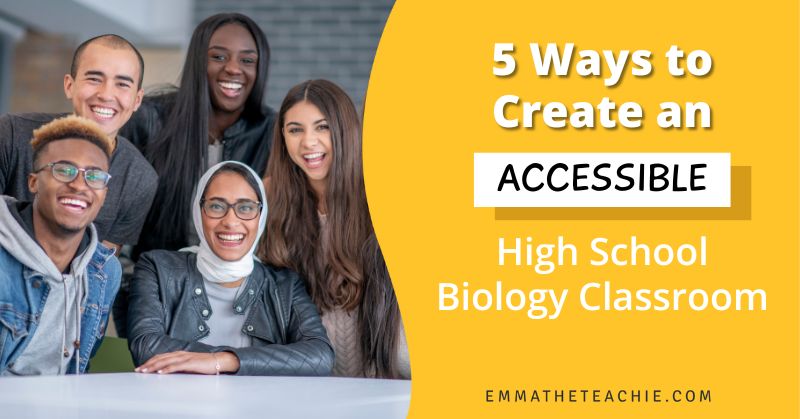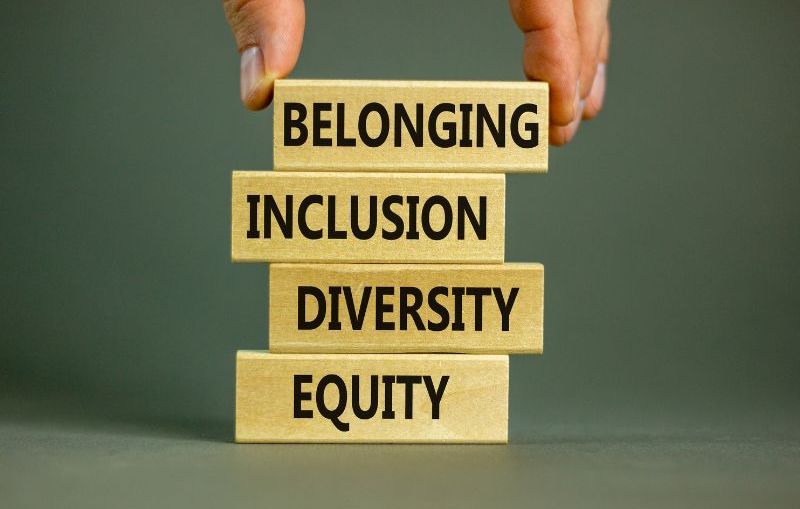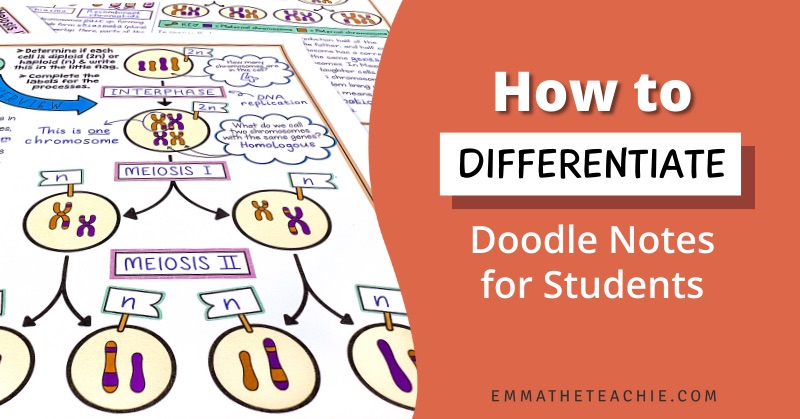
5 Ways to Create an Accessible High School Biology Classroom
I am so excited about this blog post!
Accessibility and diversity are passionate topics of mine and I can’t wait to share this with all of you.
As educators, it is our responsibility to create an inclusive and stimulating learning environment for all students.
In a high school biology classroom, fostering accessibility and celebrating diversity is crucial to ensure that every student can engage with the subject matter effectively.
In this blog post, we will explore 5 strategies and techniques that science teachers can implement to establish an accessible high school biology classroom.
Let’s not wait another moment!

1 – Incorporate culturally diverse content
In my opinion, this is one of the most important things to do, but one of the most neglected.
You’d be amazed at how a student’s engagement changes once they see someone that looks like them or has the same background as them.
One way to do this is in the displays we use in our classroom. Here is an amazing free poster set of diverse STEM role models. Simply print a set, and voilà – you have a classroom display ready to go! They even come in multiple languages (see point 5 below).
You can also integrate biology topics and examples that relate to students’ diverse backgrounds and cultures.
- Biomolecules – use culturally diverse foods in examples
- Genetics – create examples of inheritance of traits, e.g. dimples or attached earlobes, in famous actors from different backgrounds
- Disease – discuss how disease can disproportionately affect people, e.g. sickle cell anemia, diabetes, etc. as can medical treatments, e.g. stem cell therapy
By including content that students can relate to, they will feel more engaged and connected to the subject matter.
Encourage students to share their own cultural knowledge and experiences!
You can also take it a step further and invite guest speakers from diverse backgrounds or invite students to present on biology topics related to their own cultural heritage.
This approach will not only foster inclusivity but also enrich the learning experience by providing a broader understanding of biology.

2 – Encourage collaboration
Collaborative learning environments encourage students to work together, fostering a sense of community and inclusivity.
Create opportunities for students to work in diverse groups, ensuring that each group includes students with different abilities, backgrounds, and specific needs. This approach promotes teamwork, empathy, and understanding among students.
Encourage students to value the contributions of each team member and provide support and guidance when necessary.
Read How to Run Group Activities in High School to get three tips for how to make this work for you and your students.

3 – Explore Universal Design for Learning (UDL)
Universal Design for Learning is an educational framework that aims to provide multiple means of representation, expression, and engagement. By adopting UDL principles, teachers can accommodate diverse needs, preferences, and interests of students, making the curriculum accessible to all.
- Multiple Means of Representation: In the biology classroom, this can be achieved by incorporating a range of resources such as text, images, videos, and interactive simulations. Providing different representations of information helps students with different learning styles and language abilities access and process the content effectively.
- Multiple Means of Engagement: To promote engagement and motivation among students, it is crucial to offer a variety of options for them to interact with the biology content. By providing choice and autonomy, students can demonstrate their understanding in ways that align with their strengths and interests.
- Multiple Means of Expression: Allow students to express their understanding and knowledge in different ways. This approach allows students to showcase their comprehension and critical thinking skills in a way that best suits their strengths.
4 – Create an accepting classroom environment
An inclusive classroom culture begins with establishing clear guidelines and expectations for behavior.
This makes up one of my lessons at the start of the new school year, which you can read more about here: 5 Must-Do’s in Your First High School Science Lessons.
I also make it part of my class syllabus, which each student is given a copy of. You can get a free template of my science syllabus here: Science Syllabus Template.
As teachers, we need to lead. Emphasize the importance of respecting differences. Address bullying and discrimination promptly and proactively to ensure the well-being of all students.
I love to encourage open discussions and create opportunities for students to share their thoughts and experiences. You’d be surprised what students are willing to share and discuss when they feel their voices are heard.

5 – Provide language support to students who need it
For students who are English language learners or have language difficulties, it is essential to provide language support in the biology classroom.
Offer bilingual resources, such as vocabulary lists, and use simplified language when explaining concepts. Digital translation tools that are brilliant if you’re using devices in the classroom.
- The Google Translate Chrome extension is a must have – it can translate entire web pages with the click of a button.
- The Toucan Chrome extension is also great for blending languages – it translates a few words here and there into the language you are trying to learn. Here is the Toucan page for Spanish speakers learning English.
When working on collaborative assignments, pair English language learners with proficient English speakers for peer support. This not only helps with language development but also promotes intercultural exchange, acceptance, and understanding.
Ensuring all learners can understand the material is a key factor in creating an accessible high school Biology classroom.

Celebrate, support, and accept everyone
I hope you enjoyed reading this blog post as much as I loved writing it.
Creating an accessible high school biology classroom is crucial for ensuring that all students have equal opportunities to engage with the content.
By embracing different learning styles and abilities, fostering inclusive teaching practices, cultivating an inclusive classroom culture, and addressing language and literacy barriers, we can create an environment that supports the success of all students.
As educators, it is our responsibility to create an inclusive space where every student feels valued, respected, and empowered to explore the fascinating world of biology.
Together, let’s build a classroom that celebrates diversity and promotes accessible learning for all.
I hope you have a wonderful day,



